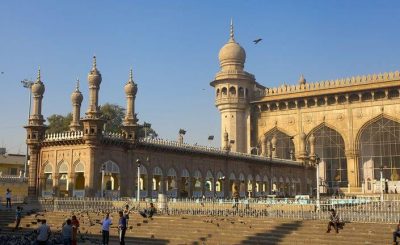Ajmer Sharif is the Sufi temple of the Sufi saint (Dargah). It is located at Ajmer in Rajasthan of India. The tomb of the revered Saint Moinuddin Chishti is in the temple (Dargah). The Dargah of Moinuddin Chishti is an international Islamic maternity which is managed by the Dargah of the Government of India, Khwaja Sahab Act, 1955.
Ajmer Sharif Dargah is situated at the foot of the hill of Taragarh, and several white marble buildings have been arranged around two courtyards, in which Nizam of Hyderabad and a huge gate constructed by Akbar, mosque provided by Mughal emperor Shah Jahan. In it, there is a domed grave of the saint.
Akbar and his queen used to follow a pledge each year on a pilgrimage from Agra to pray for a son here on foot. On the whole path between Agra and Ajmer, there is a large pillar named ‘Kos’ (Mile), which stands at a distance of a mile (3 km). These are the places, where royal pilgrims stop every day.
After the Nizam Gate, Shahjahani gate, the main gate of the temple was erected by the Mughal emperor Shah Jahan. In return, the bulldog door, made by Sultan Mehmood Khalji, is mounted on which the flag is hoisted. The death anniversary of Moinuddin Chishti is celebrated every year on the 6th and 7th day of Rajab.
Dargah Committe takes care of the maintenance of it, and runs a charitable institution such as a dispensary for the devotees, and the guest house, but does not take the rituals of the main dargah, which is in the custody of the hereditary priests.
Dargah Sharif or Ajmer Sharif is one of the most sanctified shrines in the country. It is located in the heart of Ajmer. This dargah is worshiped by both Muslims and Hindus. There are 10 interesting facts about Ajmer Sharif that will surprise you:
- Every day after Namaz, “qawwali” is sung by devotional singers inside the hall of Ajmer Sharif, Mehfil-e-Sama.
- Nizam Sikka, an ordinary water carrier, once saved Mughal Emperor Humayun’s life. As a reward, he was granted the right to rule the Mughal Empire for a day. The tomb of Nizam Sikka is situated inside the Dargah Sharif.
- Inside the dargah, you’ll find two deghs (pots) that are used for cooking Niaz – a mixture of rice, saffron, nuts, ghee, sugar and dry fruits. The food is cooked at night and distributed to the public as tabarruk (blessing) after the morning prayers.
- 15 minutes before the evening prayers, as a part of the daily ritual, the dargah workers place candles inside lamps and recite Persian verses accompanied by rhythmic drumbeats in the background. After the recital of the verses, lamps are placed in four corners of the tomb and lit. This ritual is known as roshnee (lighting ceremony).
- Placed to the west of the shrine, the Jannati Darwaza is a beautiful gate covered with silver metal. It is opened only four times in a year during the annual festival of Urs, twice on Id, and during the Urs of Khawaja Saheb’s Pir.
- Ajmer Sharif organized a 6-day annual festival of Urs in memory of the death anniversary of the Sufi saint, Moinuddin Chishti It is believed that the saint had himself shut himself in a room and when he was 114, his mortal prayed for six days before leaving the body.
- Many devotees flock here during this time of the year. The surprising aspect is that food is served to people by devotees standing inside the scalding hot cauldrons.
- Inside Ajmer Sharif, Akbar Mosque was built as a symbol of his recognition after the birth of his son, Jahangir. Today, it has become the Quran Education Institute which provides religious education to children.
“Historical place for Sunni tradition, people of every religion have been gathered here.”





